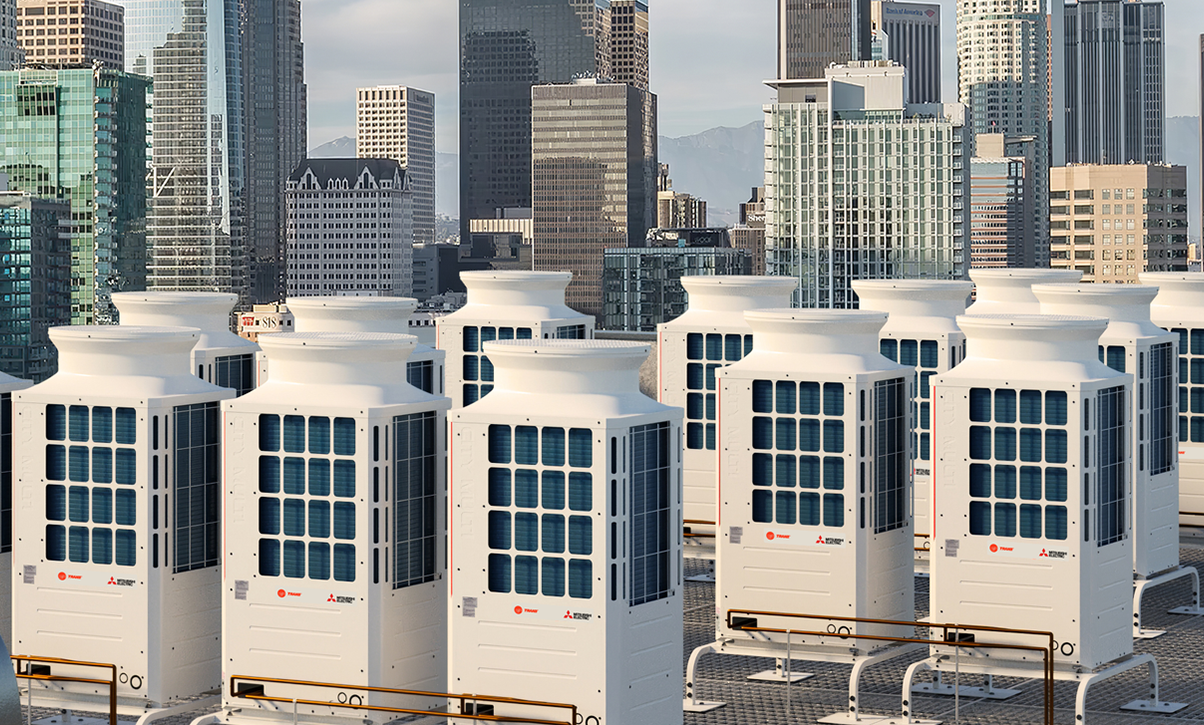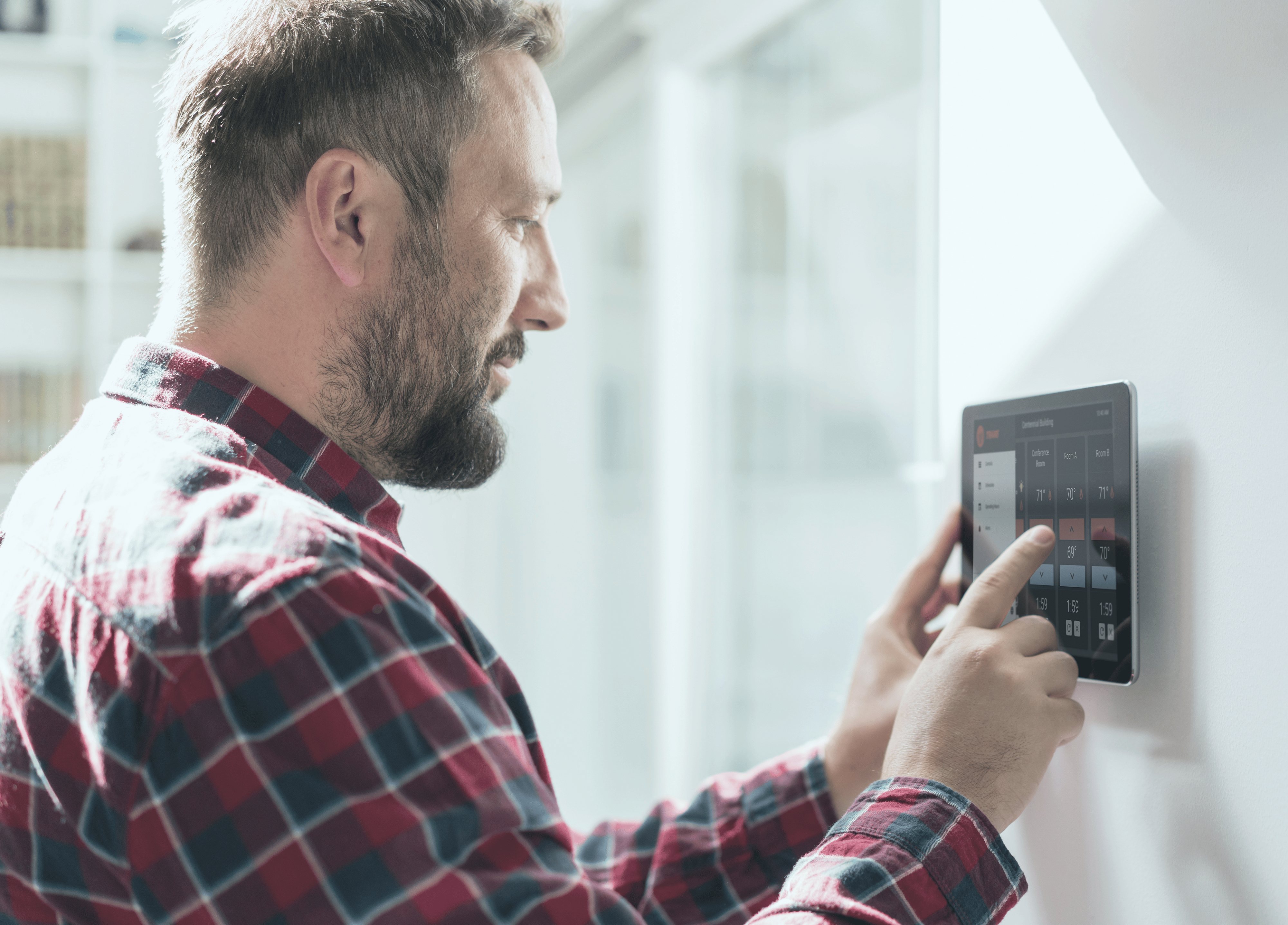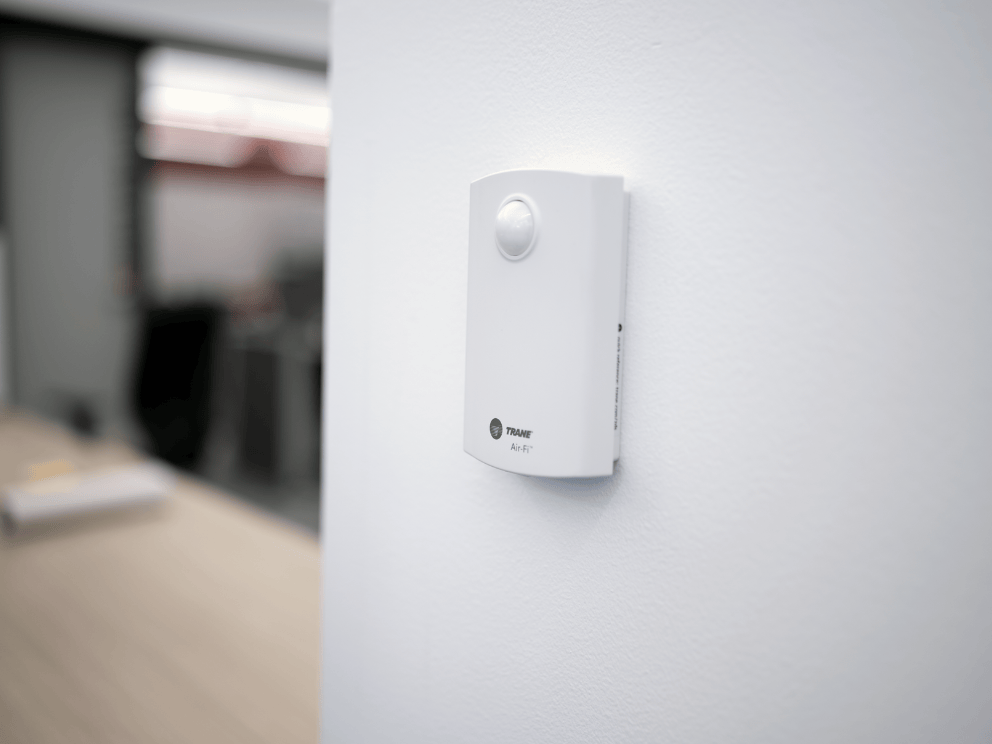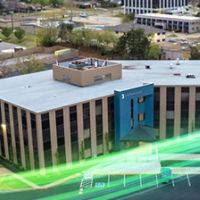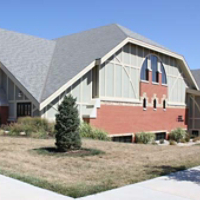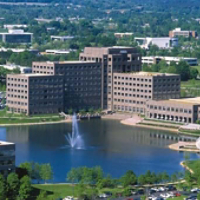Whitepaper
Published: September 26, 2022
Pairing Building Automation and VRF Systems
Trane's Tracer SC+ building automation system elevates Trane / Mitsubishi Electric VRF system performance through energy optimization, data analytics, and remote connectivity. Pairing these technologies in commercial spaces maximizes efficiency and helps achieve decarbonization goals.
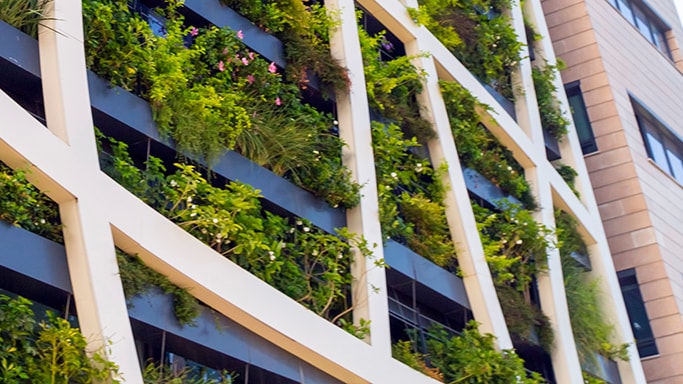
Quick Facts

The advancement of building decarbonization may become the greatest legacy of today’s engineers. For years, climate experts have been sounding alarms about the risks of allowing greenhouse gas (GHG) emissions to continue unchecked. Now, it’s time for action.
In fact, change is becoming necessary in many places. More than 20 states have established mandatory decarbonization goals.[1] Also, more than 45 states have utility incentives for the use of electrified equipment in buildings.[2]
Switching to all-electric HVAC is a logical place to begin. Experts believe that the replacement of fossil fuel-based heating systems with efficient, all-electric technologies will reduce energy use by more than 40 percent and carbon emissions by more than 75 percent.[3]
Trane and other manufacturers are reimagining electrified heating and introducing solutions that are efficient, reliable and affordable. Many systems are based on heat pumps, including variable refrigerant flow (VRF). In North America, heat pump technology is becoming a go-to for all-electric, fossil-fuel free heating and cooling. Over 180 million heat pumps were used for heating in 2020; the International Energy Agency (IEA) estimates heat pumps could satisfy 90 percent of global heating needs with a lower carbon footprint than gas-fired condensing boilers.[4] It’s a proven technology with new application opportunities.
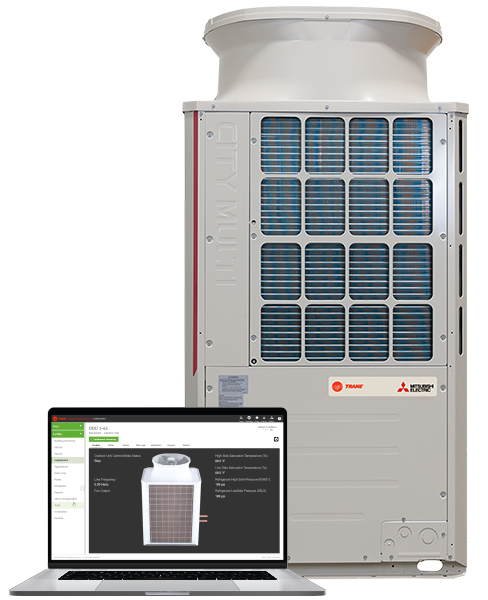
VRF and BAS: Two solutions are better than one.
Invented in 1982 in Japan, VRF systems have a mature market in Asia and Europe. Adoption in the United States has been gaining traction for a decade, with 19 percent growth (CAGR) between 2009 – 2019.[5]
There are several reasons why VRF systems are uniquely positioned to help building owners meet today’s CO2 reduction goals while lowering utility costs. They may not require ductwork, so they are ideal for bringing older buildings up to date with new standards. They can provide zoned, personalized comfort management and indoor environmental quality benefits. VRF systems are highly energy efficient and designed for extended life cycles to provide sustainable, cost-efficient comfort well into the future. And it gets even better when a building automation system (BAS) is in control.
Just as digital transformation is reaching into virtually every aspect of our daily lives, building connectivity is becoming the norm. When the goal is high-performing, decarbonized buildings, the VRF system is only half of the solution.
More VRF Control. So comfort and efficiency are a given.
Building automation can greatly increase the benefits of VRF systems by controlling energy consumption holistically. According to research conducted by the scientific teams of Project Drawdown, building automation systems can boost heating and cooling efficiency by more than 20 percent and reduce energy use for lighting, appliances, etc. by 8 percent. Globally, BAS adoption ranges from 0 to 75 percent in high income countries. Substantially expanding adoption—at a net first cost of US $287.70-393.35 billion—could save building owners $2.27-3.42 trillion (US) in operating costs. It could also avoid 9.55-14.01 gigatons of CO2 emissions by 2050.[6]
Pairing VRF with Building Automation – Better Together
BAS paired with VRF provides three significant advantages:
1. It measures performance and identifies opportunities.
Standalone VRF controls can optimize the system, but they don’t enable the continuous commissioning that BAS can. Massive amounts of energy data collected by the BAS gives building owners the insights they need to measure baseline energy usage, monitor for deviations and implement operational changes to correct inefficiencies that can develop over time. BAS opens the door to endless opportunities to improve system efficiency. Best of all, BAS users can do this all securely and remotely.
2. It elevates VRF’s zone advantages.
One thing building owners love about VRF is its ability to deliver flexible, zoned comfort. BAS takes that flexibility to the next level. While any VRF system can include i-see sensors and Smart ME thermostats, BAS adds the capability to use those sensors with multiple systems. With BAS, occupants can adjust temperature, fan speed and air flow direction to suit personal preferences. The BAS periodically sweeps settings, generally at night, resetting the system back to normal conditions (and optimal energy efficiency) for the next day.
Additionally, occupancy sensors can detect whether people are in a space or not. When people exit, the sensors communicate the information to the BAS which automates the appropriate equipment responses to conserve energy and helps to reduce operating costs.
This flexibility to personalize comfort and restore engineered efficiency settings differentiates BAS for its ability to balance comfort, cost-efficiency and sustainability.
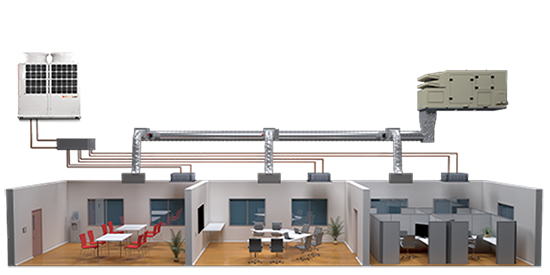
3. It coordinates multiple systems.
The action of one building system can—and should—impact the reaction of others. Building automation acts like a quarterback to keep multiple systems working as a team to optimize building performance.
Here are two example scenarios:
- Scenario 1: DOAS ventilation setpoints can be adjusted by the BAS based on occupancy and/or CO2 concentration to optimize indoor air quality while preventing over ventilation and excessive energy use.
- Scenario 2: The BAS can run the DOAS to intentionally over ventilate the space to take advantage of free cooling. This scenario helps to reduce energy use and cost because the building relies less on the VRF system to provide mechanical cooling.
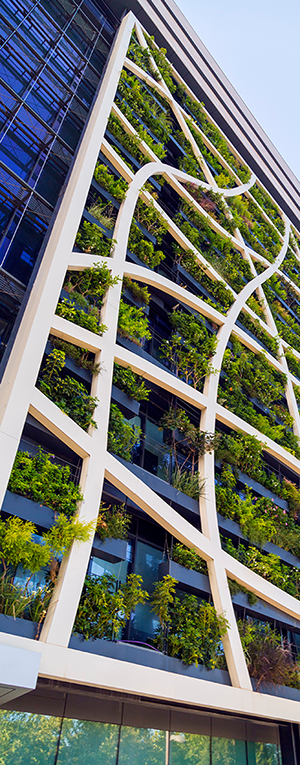
More VRF advantages. So the future of sustainable buildings is clear.
Whether driven by regulations or stakeholder values, sustainability is a bigger priority for many building owners today--but rarely is it the only deciding factor. VRF’s growing popularity may stem from its ability to do more for building owners and occupants.
Personalization keeps occupants comfortable. VRF systems allow for multiple set points that are specific to occupant usage and individual comfort preferences. Rather than maintaining an average temperature setting across the system, VRF lets each occupant choose. For example, one employee can set their office to 65° F while their neighbor selects 72° F. Individuals can also have control over fan speed and air-flow direction for truly personalized comfort.
Greater retrofitting flexibility makes it easier to improve the sustainability of existing buildings. VRF systems are more compact and require less ductwork than conventional equipment. Additionally, their smaller footprint means they require fewer alterations to building facades, making them ideal for owners and developers who want to maintain the integrity of historical buildings.
They’re quiet. Lower operating sound levels mean the equipment will not disturb guests inside rooms. It also keeps surrounding outdoor spaces free from disruptive mechanical noise, which makes them more suitable for use near profit-generating amenities like rooftop restaurants or entertaining spaces.
They’re electric. The grid is getting greener. In 2022, solar and wind are expected to add more than 60 percent of the utility-scale generating capacity to the U.S. power grid (46 percent from solar, 17 percent from wind).[7] Electrified heating taps into the sustainability benefits of electricity that is generated using cleaner energy sources. Additionally, the electrification of heat is one of the biggest steps to reduce buildings’ direct fossil fuel use. In the United States, 13 percent of GHG emissions are caused by the direct use of fossil fuels for cooling, heating and cooking.[8] As we move toward a fully renewable grid, electrified buildings will be better prepared for the clean energy future.
And they’re energy efficient. The heat pump technology at the core of VRF systems is inherently energy efficient. Instead of water or air, they use refrigerant to move heat throughout a building. VRF systems’ advanced control capabilities allow for the modulation of refrigerant that’s sent to each zone according to occupancy-based demand, which reduces the amount of energy that can be wasted by heating or cooling spaces unnecessarily.
VRF helps communities and organizations meet sustainability targets. Utilities, states, cities, agencies and nonprofits have published a steady stream of studies and reports on how strategic electrification is the best way to achieve ambitious carbon emission reduction goals. Research conducted by the Vermont Energy Investment Corporation (VEIC) for the New York State Energy Research and Development Authority (NYSERDA) showed GHG emission reductions of up to 41 percent for older large office buildings retrofitted with VRF systems. The equipment included in the study demonstrated baseline VRF system performance and didn’t include the most highly efficient models or BAS-enablement that are possible today. Additional energy savings and reductions in GHG emissions are possible with newer equipment designed for cold-climate performance and higher integrated energy-efficiency ratios (IEER) and COP ratings.[9]
Here are a few additional things to keep in mind:
- Most efficiency advantages occur during partial-load conditions. VRF systems continually adjust capacity and energy consumption to precisely match each zone’s load.
- While gas-fired HVAC systems can’t exceed a coefficient of performance (COP) of 1, VRF systems regularly achieve COPs of 3 and higher, meaning they can deliver much more heat than they consume in watts.
- VRF systems require less ductwork than forced-air systems which reduces the amount of energy consumed by fans.
A high-performance building will have efficient mechanical systems as well as low heating and cooling loads achieved through continuous insulation and an airtight thermal envelope. The ability of a VRF system to match capacity with loads enables it to heat and cool a low-load building with less risk of short cycling than fixed-capacity equipment.
Trane offers VRF and BAS solutions. So any building can decarbonize.
Trane’s answer is the line of Trane® / Mitsubishi Electric VRF systems paired with Tracer® SC+ building automation. Both heat pump and heat recovery options are available to suit a wide range of applications. Trane’s VRF experts can help you understand the nuances when you need to choose the best option for a particular type of building or customer.
Pre-engineered applications optimize HVAC electrification.
As we’ve discussed, VRF delivers its greatest potential when paired with building automation. Trane’s BAS solution, Tracer SC+, delivers reliable performance that is pre-engineered by our own in-house system experts. Programming key system applications in our factory, before delivery, is a unique step in Trane’s BAS production process. It ensures each VRF system performs consistently to maximize system advantages for buildings that are leveraging electrified HVAC to decarbonize.
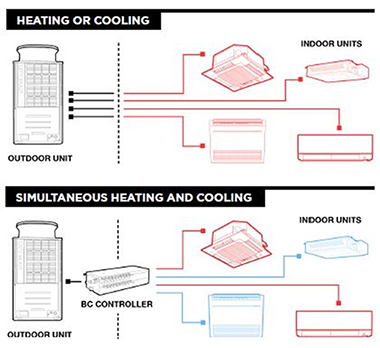
Understanding VRF System Types
Heat Pump VRF technology consolidates heating and cooling into one all-electric, multi-zone system for a range of commercial applications. This type of VRF system consists of an outdoor unit and up to fifty indoor units connected via refrigerant lines and a communications network. Each zone is conditioned by its own indoor unit(s) which can have unique set points. Instead of burning fossil fuels, VRF heat pumps provide heating to zones by introducing ambient heat that the outdoor unit extracts from the air or a nearby water source. During cooling, VRF heat pumps reverse this process: indoor units transfer excess heat from zones to the outdoor unit which then rejects the heat. Indoor units are available in ductless and ducted styles.
Heat Recovery VRF systems have the same capabilities as VRF heat pumps, but they also use a branch circuit (BC) controller to leverage load diversity and provide simultaneous heating and cooling. They can move heat from zones that require cooling to zones that require heating. By repurposing thermal energy that would have been rejected by the outdoor unit, heat recovery systems increase total applied capacity and energy efficiency.
- Occupied and unoccupied space condition – conditions a space utilizing VRF and a Dedicated Outdoor Air System (DOAS) to leverage each of their strengths in maintaining sensible or latent loads for comfort and energy usage.
- Fan pressure optimization – implements strategies such as demand control ventilation or duct static reset with Ventilation Flow Control boxes to optimize energy use in spaces with varying ventilation demands.
- Optimal Start / Stop – proactively satisfies the required conditions in the space with a targeted setpoint and time for occupant use.
- Demand Management – manages energy costs and comfort with a strategy for demand and supply management, thereby minimizing peak demand and the associated charges.
- Ventilation discharge air condition optimization – manages the discharge air temperature and humidity control of the ventilation system.
Trane has more VRF and building automation expertise. So you have one ‘go-to’ for everything.
Specifying VRF systems paired with building automation may not be within your comfort zone. But many building owners are facing strong external pressures to decarbonize over the next few years. Designing a system with VRF and BAS can help prioritize sustainability goals and maximize overall building efficiency and performance. You can provide VRF expertly, right now, with the support of Trane. Our free, web-based design tool is available to guide you through system specifications. For additional support, you can contact the local Trane Account team. We can help you specify and design VRF systems that meet new efficiency standards and fulfill electrification requirements for virtually any building.
If you want to become the VRF expert in your local market, here's everything you really need to know: Trane’s broad portfolio includes both VRF and BAS products. Our expertise can help you design, program, and deliver turnkey systems for even the most specific project requirements. After installation, we can use data from the BAS to generate analytics that inform proactive service, maintenance and optimization. The best solutions for any building depend on a multitude of factors, from the building’s size and function to the location and climate zone. Trane’s VRF experts can help you assess each situation and provide the best, future-forward solutions.
[1] Clean Energy States Alliance, Table of 100% Clean Energy States. Web.
[2] DESIRE, NC Clean Energy Technology Center, Database of State Incentives for Renewables & Efficiency. Web.
[3] Frost & Sullivan, Global Electrification Grown Opportunities: Regulatory Frameworks, Disruptive Technologies, and the Growth of Renewables and Smart Grid Management Technologies with Guide Electrification, March2022. Web.
[4] IEA, Heat Pumps, More Efforts Needed. Web.
[5] BSRIA, US Among the Major VRF Markets in the World, June 2-21. Web.
[6] Project Drawdown, Building Automation Systems. Web.
[7] U.S. Energy Information Administration. Web.
[8] Resources for the Future 70, Federal Climate Policy 106, The Buildings Sector. Web.
[9] Northeast Energy Efficiency Partnerships Variable Refrigerant Flow (VRF) Market Strategies Report (September 2019)

